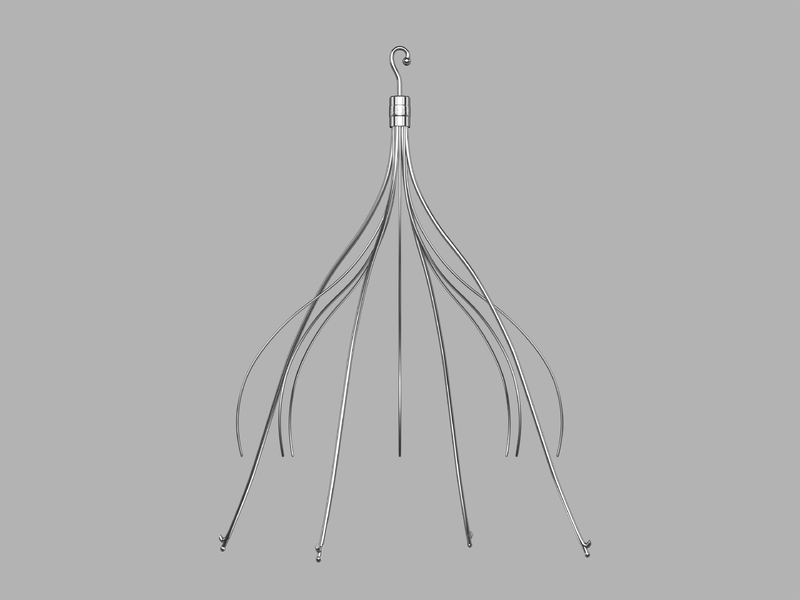INTENDED USE
The Cook Celect Platinum Filter implant is intended for the prevention of recurrent pulmonary embolism (PE) via placement in the vena cava in the following situations: • Pulmonary thromboembolism when anticoagulant therapy is contraindicated;
• Failure of anticoagulant therapy in thromboembolic diseases;
• Emergency treatment following massive PE where anticipated benefits of conventional therapy are reduced; and
• Chronic, recurrent PE where anticoagulant therapy has failed or is contraindicated. The product is intended for percutaneous placement via a femoral vein for filtration of inferior vena cava (IVC) blood to prevent PE.
CONTRAINDICATIONS
Filter Placement
• Megacava (diameter of the IVC > 30 mm).
• Diameter of the IVC < 15 mm.
• Extensive thrombus in the vein chosen for approach.
• Patients with risk of septic embolism.
Optional Filter Retrieval
• Filters with significant amounts of trapped thrombus (greater than 25% of the volume of the cone).
• Patients with an ongoing high risk for PE.
WARNINGS
Filter Placement
• If severe resistance is met when advancing the wire guide, then retract the wire guide and choose a different approach.
• When power injecting contrast media, do not exceed the maximum pressure rating of 68 bar/1000 psi and flow rate of 20 mL/sec. Hand injection is also possible.
• When inserting the preloaded filter into the Check-Flo® valve of the introducer sheath, hold the introducer with flexible tip near the end, close to the filter.
• Do not attempt to rotate the preloaded filter inside the introducer system.
• Do not attempt to rotate the expanded filter inside the vena cava.
• Excessive force should not be exerted in placement of the filter. Optional Filter Retrieval
• An inferior vena caval imaging evaluation for residual captured thrombus should be performed prior to attempted retrieval.
• Excessive force should not be exerted to retrieve the filter.
• Never attempt to re-deploy a retrieved filter.
• Please refer to the “CLINICAL STUDIES” section of the Instructions for Use for further information on filter retrieval from published clinical literature.
PRECAUTIONS
• The product is intended for use by physicians trained and experienced in diagnostic and interventional endovascular techniques.
• Standard techniques for placement of vascular access sheaths, angiographic catheters and wire guides should be employed.
• Product (filter or introducer system) modification or alteration is not recommended, as the product’s safety and effectiveness have not been established following any modifications.
• Manipulation of products (e.g., placement and retrieval) requires imaging control.
• Before injecting any contrast media (by either power or hand injection) through the introducer dilator, ensure that the introducer sheath hub and introducer dilator are correctly connected.
• Possible allergic reactions (e.g., to cobalt, chromium, nickel and platinum) should be considered.
• The use of vena cava filters in pregnant patients and (or) placement in the suprarenal position have been reported. The safety and effectiveness of the filter have not been established in these patients.
• Filter tilt has been reported. Potential causes may include filter placement in IVCs with diameters smaller or larger than those specified in these Instructions for Use; improper deployment; manipulations near an implanted filter (e.g., a surgical or endovascular procedure in the vicinity of a filter); and (or) a failed retrieval attempt. Excessive filter tilt may contribute to difficult or failed retrieval; vena cava wall penetration/ perforation; and (or) result in loss of filter efficiency.
• Vena cava wall penetration/perforation has been reported and may be either symptomatic or asymptomatic. Potential causes may include improper deployment; and (or) excessive force or manipulations near an in situ filter (e.g., a surgical or endovascular procedure in the vicinity of a filter).
• Filter fracture has been reported and may be either symptomatic or asymptomatic. Fracture of a filter leg may be due to repetitive motion on a filter leg in an unusual, stressed position, such as a filter leg penetrating/perforating the IVC; or a filter leg being caught in a side branch (e.g., a renal vein). Other potential causes of filter fracture may include excessive force or manipulations near an implanted filter (e.g., a surgical or endovascular procedure in the vicinity of a filter). Retrieval of a fractured filter or filter fragments (including embolized fragments) using endovascular techniques has been reported.
• Filter or filter fragment migration and (or) embolization (e.g., movement to the heart or lungs) has been reported. Filter or filter fragment movement has occurred in both the cranial and caudal direction and may be either symptomatic or asymptomatic. Potential causes may include filter placement in IVCs with diameters smaller or larger than those specified in these Instructions for Use; improper deployment; deployment into thrombus; dislodgement due to large thrombus burdens; and (or) excessive force or manipulations near an in situ filter (e.g., a surgical or endovascular procedure in the vicinity of a filter).
